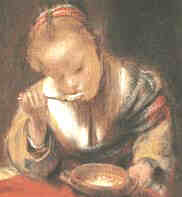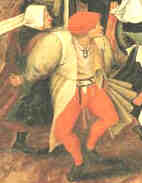 ^
11 December 2002: Old masters
auctioned at Christie's
in London.
^
11 December 2002: Old masters
auctioned at Christie's
in London.— At auction are more than 110 old master paintings and manuscript illuminations from the Bernard H. Breslauer collection. Among the highlights are two genre paintings from the Dutch Golden Age: a rare early domestic interior by Nicolaes Maes and a tavern scene by Adriaen van Ostade.
Italian painting is represented from the 16th to the 18th centuries with a masterful allegorical depiction of Faith by Vasari; an important study for a lost Royal commission by Solimena; and a remarkable Venetian view by Francesco Guardi.
Also in the sale are a pair of angels by Zurbarán and a rediscovered group portrait by Thomas de Keyser. Links to a few pictures and commentary:
— A pair by Francisco de Zurbarán [07 Nov 1598 – 27 Aug 1664]: An angel leaning forward in devotion: and An angel looking out with upturned palms (100x71cm) (estimate £700'000)
 —
The
Wedding Dance (41x54cm)
[< thumbnail] by Pieter
Brueghel II [1564-1638] (estimate £500'000)
—
The
Wedding Dance (41x54cm)
[< thumbnail] by Pieter
Brueghel II [1564-1638] (estimate £500'000)— by Pieter Brueghel II: The Misanthrope (circular 19 cm diameter) (estimate £70'000)
— by Gillis van Tilborch [1614-1684 or 1625-1678]: Elegant company at a table on a terrace (61x49cm)
— The Five Senses: three men smoking, drinking and making music (88x126cm) from the circle of Jacob van Oost the Elder [Feb 1601 – 1671] (estimate £16'000)
— by Jacob Jordaens [19 May 1593 – 18 Oct 1678]: A youth, holding a dog in check and doffing his hat as he enters a house, accompanied by a young woman (191x89cm) (estimate £85'000 — at Sotheby's, London, on 24 October 1973 it was sold as lot 37 for £4200 to A. Gurney).
— by Thomas Hendrickszoon de Keyser [1596 – 07 Jun 1667] ) Group portrait of three gentlemen, three-quarter-length, seated in black costumes with lace collars and cuffs (105x99cm) (estimate £125'000)
— The Triumph of King Charles of Naples at the Siege of Gaeta (144x120cm) by Francesco Solimena [04 Oct 1657 – 05 Apr 1747] (estimate £250'000)
— An Allegory of Faith (76x172cm) by Giorgio Vasari [30 Jul 1511 – 27 Jun 1574] (estimate £600'000)
— De Drinker: Three boors drinking and smoking in a spirit house (29x23cm) by Adriaen Janszoon van Ostade [10 Dec 1610 — 1685] (estimate £400'000)
— The Tower of Babel (93x76cm) by Mathys Schoevaerdts [1665-1722] (estimate £50'000)
— A Philosopher, seated, half-length (1645, 114x85cm) by Salomon Koninck [1609-1656] (estimate £40'000)
— An interior with a young girl eating curds from a bowl [3 thumbnails >] by Nicolaes Maes [1634 – 24 Nov 1693] (estimate £300'000)
— Portrait of Rochus van der Does, Raadsheer and Schepen of Utrecht (107x91cm) by Maes (estimate £12'500)
— from the studio of Frans Snyders [1579-1657] Dogs hunting deer in a landscape (estimate £25'000) [image]
— A pair of pair of Wooded River Landscapes by Gillis Claeszoon de Hondecoeter [1575 – Sep 1638] 1. with travelers and a dog on a path, cattle by a ford beyond — 2. with figures on a path (2 images , each 20x26cm) (estimate £35'000)
— An Italianate river landscape with drovers at a ford at dusk (24x31cm) by Nicolaes Pieterszoon Berchem [01 Oct 1620 – 18 Feb 1683] (estimate £70'000)
— An Italianate river landscape with peasants resting on the way to market, a ruined tower beyond (57x65cm) by Johann Heinrich Roos [27 Oct 1631 – 03 Oct 1685] (estimate £25'000)
—The Coronation of the Virgin, illumination from a manuscript [image]
— The Madonna and Child with Souls in Purgatory (207x155cm) by Luca Giordano [1632-1705] (estimate £50'000)
— The Holy Family (40x29cm) from the circle of Raphael (Gianfrancesco Penni?) (estimate £25'000) (it was sold at Christie's on 05 July 1918, lot 81, as Giulio Romano's La Vierge au Berceau for 14 guineas to Miss Rosa Lewis, since which an annual 9.21% appreciation would be needed to make it reach the level of the present estimate, but the pound has lost much of its value)
— The Madonna and Child with the young Saint John the Baptist (tondo, 76 cm diameter) from the workshop of Botticelli [1445 – 17 May 1510] (estimate £70'000)
— The Madonna and Child with the Infant Saint John the Baptist (1514, 119x96cm) by Mariotto Albertinelli [13 Oct 1474 – 05 Nov 1515] (estimate £20'000)
— The Madonna and Child with the Infant Saint John the Baptist (107x79cm) by Michele Tosini “di Ridolfo del Ghirlandaio” [08 May 1503 – 28 Oct 1577] (estimate £20'000)
— The Madonna and Child with Saint Peter (98.5 cm. x 62.6 cm) by Francesco Bissolo [1473 – 20 Apr 1554] (estimate £50'000)
— The Adoration by the Magi (55x69cm) by Battista Dossi [1475-1548] (estimate £85'000)
— The Rest on the Flight into Egypt (50x43cm) by Willem van Mieris [03 Jun 1662 – 27 Jan 1747] (estimate £25'000)
— Saint John the Baptist preaching in the Wilderness (79x78cm) by Jan Havickszoon Steen [1626 – 03 Feb 1679] (estimate £50'000 — it was sold at Van den Eyck, Leiden, on 31 July 1765, as lot 49 for 92 florins and at Rietmulder, The Hague, on 17 September 1770, as lot 164, De Prediking van St. Jan in de woestyne rijk geordineert, op een moderne trant, en fraay geschildert for 59 florins).
— The Marriage at Cana; and The Sermon on the Mount (40x51cm each) a pair of paintings by Franz Christoph Janneck [03 Oct 1703 – 13 Jan 1761] (estimate £40'000)
— Study of a head of a man (29x23cm) by Federico Barocci [1526 or 1535 – 1612] (estimate £50'000)
— Group portrait of the daughters of Johann Julius von Vieth und Glossenau: Juliane Corline, Edle von der Planitz (1752-1832), Sophie Juliane Elisabeth, Gräfin d'Agrollo (1748-1832) and Juliane Charlotte, Gräfin von Todtleben (1754-1840), half-length, in lace-lined dresses and with powdered hair, holding a plumed cap by Anton Graff [18 Nov 1736 – 22 Jun 1813] (86x72cm) (estimate £60'000)
— A wooded landscape with a cavalry skirmish (77x108rm) by Joost Corneliszoon Droogsloot [1586 — 14 May 1666] [he was NOT the son of a drug slut]
— A river landscape with classical figures in a boat, a hilltop castle beyond (1805, 204x143cm) by Jean-Victor Bertin [1767 or 1775 – 11 Jun 1842] (estimate £60'000)
 —
Vesuvius
erupting at night (98x128cm)
by Pierre-Jacques
Volaire “le Chevalier Volaire” [30 Apr 1729-1795] (estimate
£25'000)
—
Vesuvius
erupting at night (98x128cm)
by Pierre-Jacques
Volaire “le Chevalier Volaire” [30 Apr 1729-1795] (estimate
£25'000) —
A
stormy coastal landscape with survivors from a shipwreck on a rocky outcrop,
a tower and a ship at sea beyond (1765, 55x82cm)
by Claude-Joseph
Vernet [14 Aug 1714 – 03 Dec 1789] (estimate £110'000 —
probably purchased from the artist in 1765 for 600 livres by M. Bouilette).
—
A
stormy coastal landscape with survivors from a shipwreck on a rocky outcrop,
a tower and a ship at sea beyond (1765, 55x82cm)
by Claude-Joseph
Vernet [14 Aug 1714 – 03 Dec 1789] (estimate £110'000 —
probably purchased from the artist in 1765 for 600 livres by M. Bouilette).